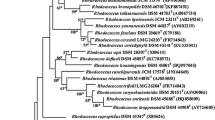Summary
The metabolism of biphenyl by Pseudomonas sp. NCIB 10643 is reported in detail; that of Nocardia sp. NCIB 10503 is briefly investigated. Both organisms dissimilate biphenyl by the same route via oxidation to 2,3-dihydroxybiphenyl, meta cleavage to a product identified as 2-hydroxy-6-oxo-phenylhexa-2,4-dienoate which is then cleaved to give benzoate. Benzoate is a deadend metabolite in the pseudomonad but in the nocardia is further catabolised to catechol and thence to cis, cis-muconate. The enzymes involved in the individual steps of the proposed pathway have been assayed. The proposed pathway differs from that previously suggested for Pseudomonas sp. NCIB 10643 but is the same as found in other pseudomonads. This is the first report of catabolism of biphenyl in an actinomycete.
Similar content being viewed by others
References
Allen CFH, Van Allan JA (1949) 3-Phenylcatechol and related substances. In: Communication No. 1252 from the Kodak Research Laboratories, pp 798–801
Baggi G, Catelani D, Galli E, Treccani V (1972) The microbial degradation of phenylalkanes. Biochem J 126:1091–1097
Boyland E, Wiltshire GH (1953) Metabolism of naphthalene by liver slices. Biochem J 53:424–426
Bradford MM (1976) A rapid and sensitive method for quantitation of microgram quantities of protein utilising the principle of proteindye binding. Anal Biochem 72:95–105
Butte W (1983) Rapid method for the determination of fatty acid profiles from fats and oils using trimethylsulphonium hydroxide for transesterification. J Chromatogr 261:142–145
Canonica L, Fiecchi A, Galli-Kienle M, Scala A, Teccani V (1966) Product of the microbial oxidation of 4-methylpyrocatechol. Gazz Chim Ital 96:915–921
Catelani D, Colombi A (1974) Metabolism of biphenyl. Structure and physicochemical properties of 2-hydroxy-6-oxo-6-phenylhexa-2,4-dienoic acid, the meta-cleavage product from 2,3-dihydroxybiphenyl by Pseudomonas putida. Biochem J 143:431–434
Catelani D, Sorlini C, Treccani V (1971) The metabolism of biphenyl by Pseudomonas putida. Experientia 27:1173–1174
Catelani D, Colombi A, Sorlini C, Treccani V (1973) Metabolism of biphenyl. 2-Hydroxy-6-oxo-6-phenylhexa-2,4-dienoate: the meta-cleavage product from 2,3-dihydroxybiphenyl by Pseudomonas putida. Biochem J 134:1063–1066
Duggleby CJ, Williams PA (1986) Purification and some properties of the 2-hydroxy-6-oxohepta-2,4-dienoate hydrolase (2-hydroxymuconic semialdehyde hydrolase) encoded by the TOL plasmid pWWO from Pseudomonas putida mit 2. J Gen Microbiol 132:717–726
Durham DR, McNamee CG, Stewart DB (1984) Dissimilation of aromatic compounds in Rhodotorula graminis: biochemical characterisation of pleiotrophically negative mutants. J Bacteriol 160:771–777
English J (1961). In: Laboratory manual to accompany principles of organic chemistry, 3rd edn. McGraw-Hill, New York, p 147
Evans WC (1947) Oxidation of phenol and benzoic acid by some soil bacteria. Biochem J 41:373–382
Furukawa K, Suzuki H (1988) Gene manipulation of catabolic activities for production of intermediates of various biphenyl compounds. Appl Microbiol Biotechnol 29:363–369
Gibson DT, Roberts RL, Wells MC, Kobal VM (1973b) Oxidation of biphenyl by a Beijerinckia species. Biochem Biophys Res Commun 50:211–219
Hayaishai O, Katagiri M, Rothberg S (1957) Studies on oxygenases. Pyrocatechase. J Biol Chem 229:905–920
Jayasuriya CGN (1955) The isolation and characteristics of oxalate-decomposing organism. J Gen Microbiol 12:419–428
Kojima Y, Itada N, Hayaishi O (1961) Metapyrocatechase: a new catechol cleaving enzyme. J Biol Chem 236:2223–2228
Lunt DO (1974) The metabolism of inter-monomer linkages in certain plant phenolics by micro-organisms. PhD thesis, University of Wales
Lunt DO, Evans WC (1970) The microbial metabolism of biphenyl. Biochem J 118:54P
Mann FG, Saunders BC (1960) In: Practical organic chemistry, 4th edn. Longmans, London
Marshall BJ, Ratledge C, Norman E (1973) Improved design for a simple and inexpensive multiplace laboratory fermenter. Lab Pract 22:491–492
Omori T, Sugimura K, Ishigooka H, Minoda Y (1986a) Purification and some properties of a 2-hydroxy-6-oxo-6-phenylhexa-2,4-dienoic acid hydrolysing enzyme from Pseudomonas cruciviae S93B1 involved in the degradation of biphenyl. Agric Biol Chem 50:931–937
Omori T, Ishigooka H, Minoda Y (1986b) Purification and some properties of 2-hydroxy-6-oxo-6-phenylhexa-2,4-dienoic acid (HODPA) reducing enzyme from Pseudomonas cruciviae S93B1, involved in the degradation of biphenyl. Agric Biol Chem 50:1513–1518
Risebrough RW, de Lappe B (1972) Accumulation of polychlorinated biphenyls in ecosystems. Environ Health Perspect 1:39–49
Robinson J, Cooper JM (1970) Method of determining oxygen concentrations in biological media, suitable for calibration of the oxygen electrode. Anal Biochem 33:390–399
Schwartz RD (1981) A novel reaction: meta hydroxylation of biphenyl by an actinomycete. Enzyme Microbiol Technol 3:158–159
Starovoitov II, Selfonov SA, Nefedova MYU, Adain VM (1986) Catabolism of diphenyl by Pseudomonas putida strain BS893 containing biodegradation plasmid pBS241. Microbiology (Engl Transl) 54:726–727
Takase I, Omori T, Minoda Y (1986) Microbial degradation of products from biphenyl-related compounds. Agric Biol Chem 50:681–686
Author information
Authors and Affiliations
Rights and permissions
About this article
Cite this article
Smith, M.R., Ratledge, C. Catabolism of biphenyl by Pseudomonas sp. NCIB 10643 and Nocardia sp. NCIB 10503. Appl Microbiol Biotechnol 30, 395–401 (1989). https://doi.org/10.1007/BF00296630
Received:
Accepted:
Issue Date:
DOI: https://doi.org/10.1007/BF00296630




